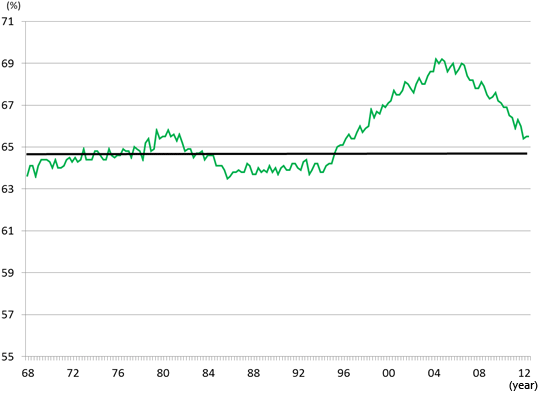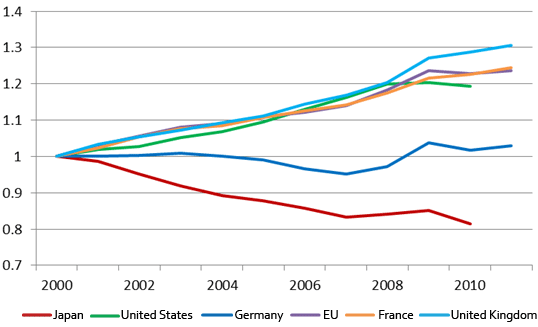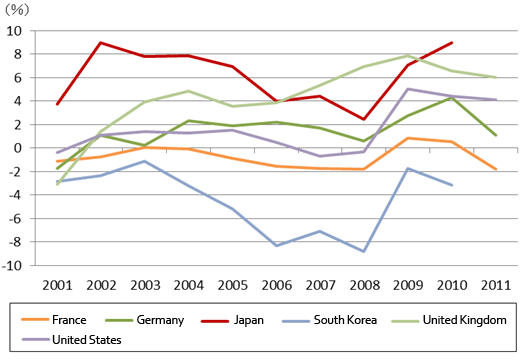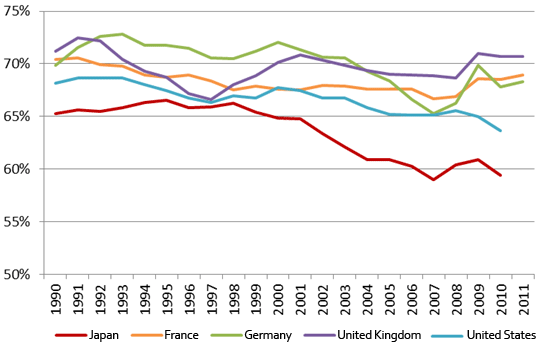U.S. and European economies recovering from their losses
In 2012, the European sovereign-debt crisis had a significant impact on the global economy. Money continued its risk-averse trend worldwide, leading to a weaker euro and falling global stock prices over the summer.
However, measures to overcome the European sovereign-debt crisis have been making steady progress. A framework to avoid a public debt issue and a financial crisis has been put in place to a large degree, such as a second round of additional loans to Greece; the establishment of the European Stability Mechanism (ESM); Outright Monetary Transactions (OMT), which is a mechanism of the European Central Bank (ECB) for purchasing government bonds; and progress toward a banking union. 2013 is expected to be a year when concerns about the debt crisis ease as the European economy experiences a bottoming out.
Yet, it is too soon to say for sure whether the series of measures will bring the debt crisis to an end. The possibility that the severe fiscal tightening Greece promised will not be pursued due to significantly negative growth cannot be ruled out. In addition, as the amount of Greek government bonds held by private financial institutions has now become very small, a severe situation might be expected in which Germany and the European Union (EU) will cut their official financing to the Greek government, and there is fear that the debt crisis may be revived after the fall of 2013 in the wake of Germany's general election, to be held in September 2013.
The U.S. economy, on the other hand, showed nothing but solid performance. The unemployment rate has fallen, and consumer spending has been steady. Above all, it is noteworthy that the recovery of the housing market has become more evident. Since the fall of Lehman Brothers, the adverse impact of the collapse of the financial bubble due to the subprime mortgage loans has shrunk considerably over the past four years, and this adjustment has progressed to the point where the housing market has returned quite close to its pre-bubble level in terms of both the ratio of household debt to disposable income and changes in the rate of homeownership (Figure 1).

Moreover, the shale gas revolution is also boosting the U.S. economy. Natural gas consumption in the United States compared with that in Europe—calculated by the differences in natural gas prices between the two—has reached 1.3% of the gross domestic product (GDP), meaning that this difference will increase GDP by 0.2%-0.3% every year. Partly helped by its avoidance of the fiscal cliff, the U.S. economy is likely to become even more stable as 2014 approaches.
Progress in both restoring fiscal health and strengthening industrial competitiveness
Likely developments in the European and U.S. economies will have certain implications in 2013. One is that both are steadily recuperating from their respective losses due to the debt crisis and the bubble, and are gradually changing their focus.
In Europe, the framework for a unified EU has made further progress in the sovereign crisis, while the United States has significantly more leeway now to tackle the issue of restoring its fiscal health, as seen by its handling of the fiscal cliff, thanks to the progress made in the aftermath of the financial bubble.
On that basis, in Europe, the need for economic growth to restore fiscal health is recognized. Meanwhile, in the United States, which is obtaining cheap and abundant energy, developments to strengthen its industrial competitiveness are becoming evident, such as the reshoring of manufacturing.
Europe, too, has become very focused on improving its industrial competitiveness. In France, for example, the government's industrial policy, which used to involve income redistribution by combining tax cuts for small companies with tax hikes for large companies, has been changing, and, on November 6, 2012, the government announced measures to support business, an essential component of which is a 20-billion-euro tax break for businesses over the next three years.
Of this 20-billion-euro tax break, 10 billion euros will come from an increase in the consumption tax, thus, the recovery of France's business competitiveness is likely to be incomplete, given the extent of its widening gap with Germany in terms of unit labor cost (Figure 2). However, the fact that the government has taken steps to strengthen the competitiveness of all companies, including large ones, is significant.

Business competitiveness isn't just being tested in European countries. The same holds true for Japan. As Figure 2 indicates, among developed countries and regions, Japan has shown the greatest improvement in unit labor cost since 2000. In terms of savings-investment balance, Japan also has the largest financial surplus in the private sector on average among developed countries, suggesting that Japanese companies are financially sound (Figure 3). Nevertheless, exports, wages, and employment in Japan have been growing at a sluggish pace. Looking at Japan from the perspective of an economy supported by business, its global growth remains low, and the country has been slow to move out of deflation.

The reason for this paradoxical state is the so-called sextuple whammy—the strong yen, electric power constraints, high effective corporate tax rates, strict targets for greenhouse gas emissions, delays in forming free trade agreements, and the rigid labor market. As a result of this, Japan's much-awaited corporate efforts are being offset.
Of course, some parts of the sextuple whammy are understandable on an individual basis, and it is impossible to eliminate it completely. However, the current situation, in which only Japanese companies are heavily burdened, must change, given the environment of global competition.
Japanese companies have significant latitude to take the lead in strengthening their business competitiveness
Just as the new administration intends to combine bold monetary easing centered around an inflation target with a large-scale supplementary budget, the yen has been weakening as a result of the market factoring in these actions in advance. Although the response needs to take into account actual economic conditions and the serious fiscal deficit, what matters is how to reduce the heavy corporate burden with a sense of speed.
Although concerns have been voiced about the widening trade deficit due to the weak yen, the risk of rising electric power prices due to increased imports and the weak yen could be mitigated if the government resumes operating the nuclear reactors whose safety has been confirmed. If a comprehensive investment tax credit and research and development (R&D) tax credit are implemented, the effective corporate tax rate could be reduced. If Japan announces its participation in the Trans-Pacific Partnership (TPP), that would also increase opportunities for Japanese companies. If these measures are implemented as a package, the business environment would change significantly, not only increasing the momentum of the Japanese economy, but also allowing its business competitiveness to recover.
To strengthen corporate vitality, it is necessary to facilitate an increase in wages and employment. Although the earnings power of Japanese companies is low compared with that of other developed countries, Japan is still undergoing the greatest labor share decrease (Figure 4). This suggests that Japanese companies have taken a cautious stance toward investment and employment expansion in the uncertain environment. However, if this continues, the lack of demand will persist. Also, if the economy breaks away from deflation without raising personal income, that could have an adverse impact on consumption. However, if an increase in base pay is restored along with breaking away from deflation, a virtuous cycle can be expected in which improved corporate earnings will lead to higher wages and employment.

Since the global economy is expected to head into a recovery in 2013, there is no other way for Japan without taking advantage of this opportunity. In addition, if the mitigation of the sextuple whammy gains momentum, it will bring significant benefits not only to Japanese companies, but also to the economy, wages, and employment. Given that there is a high likelihood that this will happen in 2013, first of all, this will be a year in which Japan will be tested as to whether it can take the lead in strengthening its industrial competiveness. Doing so will provide Japan with significant more leeway to address other major issues, such as restoring its fiscal health.

